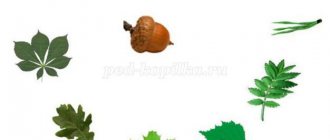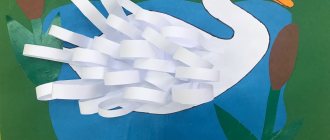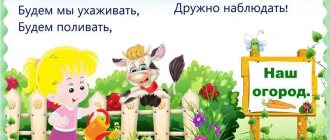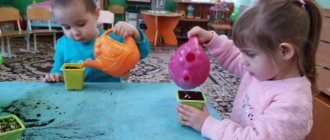Experimental activities in the senior group “Planting onions”
Experimental activities in the senior group
"Planting onions"
03/02/2021
Well-structured work is a source of inspiration and practical knowledge, a sure way to find the way to yourself and fulfillment in life. In the process of such work, interacting with adults and peers, the child gets to know himself and the world around him, and comprehensively develops his own personality. Each child will be happy to demonstrate the harvest they have grown with their own hands and will tell their loved ones with admiration what they did.
Work
- the basis of human life, therefore it is one of the main elements of educational work.
Labor education in preschool educational institutions
- an important means of comprehensive development of the personality of a preschooler through familiarization with the work of adults, introducing children to accessible work activities.
Activities related to experimentation and observation play a large role in the development of the child’s mental sphere - in the development of thinking (operations of analysis and synthesis, comparison, the ability to generalize and draw conclusions, memory, imagination, attention).
In addition, the child learns to be neat, pays attention to details, and does not lose sight of the big picture.
Children experience great interest in such activities and are inclined to independently observe objects of living nature.
It's spring, which means it's time to start planting seedlings.
We have set a goal
: to arouse children's cognitive interest in growing onion in different conditions. Find out about its benefits. Get interested in the stages of the experiment. Determine a more favorable environment for growing onions. To develop children's thinking, creative imagination and curiosity in the process of experimental and research activities in growing onions.
This work will help develop children’s interest in the plant world: create conditions for the research and experimental development of children in the process of implementing the project, identify the most favorable conditions for growing green onions
Observation
is a goal-directed perception and complex cognitive process. Based on the joint activities of children and the teacher, specific knowledge is formed that develops children’s thinking and speech. Our observation is combined with an experiment; it will be long-term. Long-term observation requires mandatory sketching (a diary) and photographic recording of each stage of observation.
Together with the children we prepared the material: wash out the sippy cups,
prepared onions, water, soil, a diary for observation, circles, felt-tip pens for sketching
Put on clothes for work
Then we select four identical bulbs.
take a close look at our bulbs
“The onion is golden. Round, cast. So hard!
There is both a bottom and a top. She is dressed in a hundred clothes
There is one in every garden. After all, the people’s favorite!”
I clarified children’s ideas about onions as a vegetable from which green onions can be grown, which are good for health. Introduced the children to the external features of the onion (round, smooth, covered with husks) Expanded their understanding of the onion, the features of the external structure, learned to find the “bottom” with roots and the top
We place them in different conditions.
Gave children an idea of the need for light, heat, and soil moisture for the growth of bulbs.
First day of observation:
— Draw children’s attention to the fact that the bulbs are smooth and hard. Where should the spine be and where should the top be?
-Question: What does a plant need to grow? -Answer: (Water, heat and light)
-For each natural phenomenon, you can choose your own symbol; - For example: water - blue circle, heat - red, light - yellow, earth - brown, darkness - black - So, let's conduct an experiment...
We put the first onion in a jar with red and blue circles. We will denote the absence of light with a black circle. Cover it with a box of black paper that is lightproof.
We put the second onion in a jar with blue, red and yellow circles.
We put the third onion in a jar without water, but in a warm place and in the light. Glue a white circle on the jar - no water. Red is the presence of heat and yellow is the presence of light.
In the fourth onion we place it in a jar with blue, red and yellow and brown circles. All conditions for growth have been created for her.
She developed in children the correct technique for planting a bulb (plant the bulb bottom down, pressing it firmly to the ground, water it with water. She consolidated knowledge about the needs of plants for soil, heat, water and light.
We planted onions and conducted the first observation of onion growth in different conditions. Involved children in collective work.
On the first day of the experiment, 03/02/2021, we make sketches of the onion and photographs. After seven days, I will invite the children to examine the bulbs and find out what changes have occurred to them.
And write the result in your diary. We watch every Monday until April 1st.
Then she suggested that the children should each try to do it on their own, just like we all did together with the second onion (The second onion was placed in a jar with blue, red and yellow circles.
For you and me, onions are the most common vegetable, but its composition is not as simple as it seems.
-Green onions protect against viral infections. -Salad with green onions will protect against colds and flu. -Onion feathers are useful for hematopoiesis. -Fresh onion greens stimulate the appetite and make any dish more attractive. -The properties of green onions promote digestion and the process of assimilation of food. -Green onions are useful for vitamin deficiency, loss of strength, drowsiness, dizziness, and spring fatigue.
— Green onions contain more zinc than other greens. -Lack of this element can cause hair loss and brittle nails.
— In addition, zinc is involved in the formation of immunity.
-Green onions contain substances that strengthen the heart muscle and the walls of blood vessels, so heart patients and simply weakened people need to pay attention to it.
Then the children worked with the “Vegetables” laptop
At the end of the first day we took a photo for memory
Benefits of green onions:
-Onions are rich in calcium and phosphorus, which is very beneficial for the condition of teeth. - It is recommended to eat onions as much as possible fresh - add them to salads, season soups, cabbage soup, borscht, okroshka, season stewed vegetables, sprinkle on mashed potatoes or boiled new potatoes. Introducing onions into dishes vitaminizes them and improves their taste. In addition, green onions improve the appearance of dishes, especially in combination with vegetables such as beets, carrots, tomatoes, and potatoes. It is used to decorate salads, various appetizers, first and second meat, fish and vegetable dishes. Green onions are necessary for the human body all year round, and especially in winter and early spring.
We'll see you in seven days. The girls and boys did a good job. We agreed to continue observing and recording the data in a diary. grow our onion at home , and use its greens - cut them off and take them to the kitchen to enrich dishes with vitamins.
MAGAZINE Preschooler.RF
Lesson summary for the senior group “Planting onions”Objectives: To consolidate children's knowledge about the properties of onions; teach how to plant bulbs in soil and water.
Tasks:
Educational:
- Clarify children's knowledge about what plants can be grown from.
- Clarify children's knowledge about the characteristic features of onions
- Exercise children in the correct techniques for planting bulbs.
Educational:
- Develop mental processes.
- Develop and maintain activity, initiative and independence in
cognitive activity.
Educational:
1. Cultivate a desire to care for onions grown with your own hands.
Material: bulbs, earth, water.
Equipment: disposable cups, 20-25 cm sticks, mayonnaise jar, watering can, magnifying glass, character “Why” .
Progress of the experimentation lesson:
The teacher asks a riddle.
The grandfather sits, wearing a hundred fur coats, and whoever undresses him sheds tears. - Onion.
Educator: There are plates on your table covered with a napkin. Want to see what's there?
- Yes.
Educator: Then let's open it. But before we start working, we need to remember the safety rules:
- Do not put onions and soil in your mouth.
- Do not put dirty fingers in your mouth or rub your eyes with them.
Educator: Take the onion in your hands. Tell me, what color is the onion? (Children's answers)
- What shape is it? (Children's answers)
- Touch it with your finger and say: is the onion hard or soft? (Children's answers)
- Now I’ll cut the onion, smell the onion. What does it smell like? (Children's answers)
- Why are you crying? (Children's answers)
- Yes, onions sting the eyes and make everyone cry. Who wants to treat themselves to onions? What do onions taste like?
Children: Onions are bitter, but they are very healthy, they contain a lot of vitamins.
- What do you think will happen to the onion if you plant it in water or soil? (Children's answers)
The teacher shows a sprouted onion.
— Do you want to try yourself as a gardener and grow green onions? After all, it also contains a lot of vitamins.
Children: Yes!
Educator: Let's try to plant onions in water. But first we need to determine where the top of the bow is. Take a magnifying glass in your hand and look carefully at the onion. Try to determine where green onions will grow from?
Children: Onions have a top, this is where green onions grow. (Show)
Educator: But the bottom of the onion is the bottom. (Show) Let's say together: “Donce” . (Children repeat) Examine the bottom with a magnifying glass. What do you see?
- Little roots.
Educator: Onions need to be planted bottom down. Let's plant one onion in a jar of water.
The teacher asks one child to bring water, and the other to bring a watering can with water.
- Look, I’m pouring water into a jar from a watering can. Now we need to plant the onions. Remind me how to plant onions. (Children's answers) Show me where the bottom of the onion is? (Children show)
The teacher invites one of the children to plant onions. (The child plants onions)
Now let's relax a little and play the game "Grow, Grow the Onion"
You will be the onion, and I will plant the onion in the ground, bottom down. Everyone sat down. Now I take a watering can and pour water on the onions. The onion begins to grow and green leaves appear. The green onions are getting big and big. So our green onions have grown. (Children stand up)
There is a knock on the door. The teacher brings in the hero “Why” and asks on his behalf what the children are doing. (Children's answers)
Then the teacher, on behalf of the hero, says that he knows another way to plant onions (in the ground).
- Do you want to get acquainted with this method?
- Yes!
- Come to the table. Take a glass, scoops and fill the glass with soil. Now take the onion in your hands. Find the bottom of the onion. Onions should be planted bottom down. Make a depression in the ground using sticks, place the onion in it, bottom down, and press the soil tightly around the bulb.
The teacher, together with the hero, praises the children for the work done.
Educator: What do you think needs to be done for green onions to start growing?
- Water it.
- Right. Take a watering can and carefully water it. Don't pour too much water.
The teacher on behalf of the hero says: “Well done! You all did a good job planting the onions. Well, it’s time for me, goodbye, kids .
Educator: Let's put the onions on the windowsill and observe where the onions grow faster in water or in the ground? Let's put sticks in glasses with onions and when the onion is the same height as the stick, you can cut it off for lunch.
Summary of the lesson.
What did we look at? (Onion) What shape is the onion? (Round, oval) What is it: hard or soft? (Hard) What does onion taste like? (Bitter)
How to plant onions correctly? (bottom down)
What conditions are necessary for greenery to grow? (Water)
Children watch the onion grow and record the results in an album.
Authors: Olga Yuryevna Frolova, teacher at MBDOU No. 188 Tatyana Nikolaevna Belkova, teacher at MBDOU No. 188 Kemerovo
| Next > |
Project “Growing Onions”
Progress of the experimentation lesson:
The teacher asks a riddle.
The grandfather is sitting, wearing a hundred fur coats,
Who undresses him?
He sheds tears.
- Onion.
Educator: There are plates on your table covered with a napkin. Want to see what's there?
- Yes.
Educator: Then let's open it. But before we start working, we need to remember the safety rules:
1. Do not put onions and earth in your mouth.
2. Do not put dirty fingers in your mouth or rub your eyes with them.
Educator: Take the onion in your hands. Tell me, what color is the onion? (Children's answers)
- What shape is it? (Children's answers)
- Touch it with your finger and say: is the onion hard or soft? (Children's answers)
- Now I’ll cut the onion, smell the onion. What does it smell like? (Children's answers)
- Why are you crying? (Children's answers)
- Yes, onions sting the eyes and make everyone cry. Who wants to treat themselves to onions? What do onions taste like?
Children: Onions are bitter, but they are very healthy, they contain a lot of vitamins.
- What do you think will happen to the onion if you plant it in water or soil? (Children's answers)
The teacher shows a sprouted onion.
— Do you want to try yourself as a gardener and grow green onions? After all, it also contains a lot of vitamins.
Children: Yes!
Educator: Let's try to plant onions in water. But first we need to determine where the top of the bow is. Take a magnifying glass in your hand and look carefully at the onion. Try to determine where green onions will grow from?
Children: Onions have a top, this is where green onions grow. (Show)
Educator: But the bottom of the onion is the bottom. (Show) Let's say together: “Donce.” (Children repeat) Examine the bottom with a magnifying glass. What do you see?
- Little roots.
Educator: Onions need to be planted bottom down. Let's plant one onion in a jar of water.
The teacher asks one child to bring water, and the other to bring a watering can with water.
- Look, I’m pouring water into a jar from a watering can. Now we need to plant the onions. Remind me how to plant onions. (Children's answers) Show me where the bottom of the onion is? (Children show)
The teacher invites one of the children to plant onions. (The child plants onions)
Now let's relax a little and play the game "Grow, Grow the Onion"
You will be the onion, and I will plant the onion in the ground, bottom down. Everyone sat down. Now I take a watering can and pour water on the onions. The onion begins to grow and green leaves appear. The green onions are getting big and big. So our green onions have grown. (Children stand up)
Educator: Let's put the onions on the windowsill and observe where the onions grow faster? Let's put sticks in glasses with onions and when the onion is the same height as the stick, you can cut it off for lunch.
On the topic: methodological developments, presentations and notes
Diary of observations of a speech therapist (child's full name) _________________________________________________________________________ visits a speech therapy group with _____________________ with a diagnosis of ______________.
Relevance of the topic: • Activities related to experimentation and observation play a big role in the development of the child’s mental sphere - in the development of thinking.
Diary of observations of onions and viburnum branches.
Observation is the main means of understanding nature. It makes it possible to introduce children to natural phenomena and the relationship between living and inanimate nature. It is observation that helps preschoolers see.
Source







